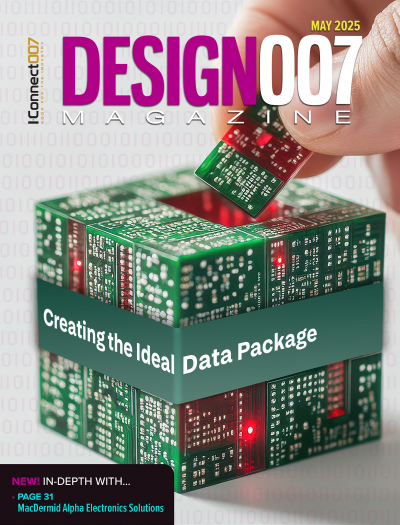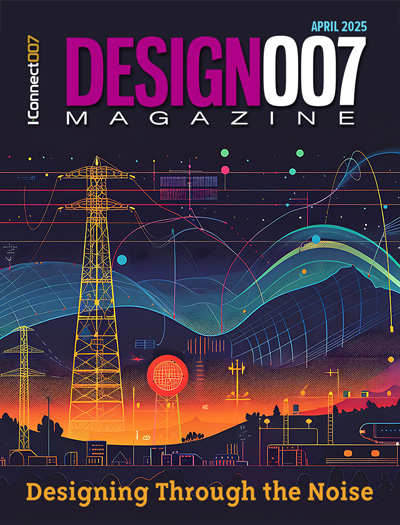-

- News
- Books
Featured Books
- design007 Magazine
Latest Issues
Current Issue
All About That Route
Most designers favor manual routing, but today's interactive autorouters may be changing designers' minds by allowing users more direct control. In this issue, our expert contributors discuss a variety of manual and autorouting strategies.

Creating the Ideal Data Package
Why is it so difficult to create the ideal data package? Many of these simple errors can be alleviated by paying attention to detail—and knowing what issues to look out for. So, this month, our experts weigh in on the best practices for creating the ideal design data package for your design.

Designing Through the Noise
Our experts discuss the constantly evolving world of RF design, including the many tradeoffs, material considerations, and design tips and techniques that designers and design engineers need to know to succeed in this high-frequency realm.
- Articles
- Columns
- Links
- Media kit
||| MENU - design007 Magazine
Book Excerpt: Thermal Management With Insulated Metal Substrates, Part 3
July 1, 2020 | Didier Mauve and Ian Mayoh, VentecEstimated reading time: 2 minutes
The following is an excerpt from Chapter 3 of "The Printed Circuit Designer's Guide to... Thermal Management With Insulated Metal Substrates," written by Ventec International Group’s Didier Mauve and Ian Mayoh. In this free eBook, the authors provide PCB designers with the essential information required to understand the thermal, electrical, and mechanical characteristics of insulated metal substrate laminates.
Chapter 3: Developments in Insulated Metal Substrate Laminates
The insulated metal substrate concept is not new. Materials were available as long ago as the mid-1960s for specific niche-market applications. However, the exponential growth in LED lighting has been the main driver for the development of improved versions in volume manufacture. Insulated metal substrate laminates are now firmly established as the preferred base material for the fabrication of printed circuits for high-brightness LED lighting and DC power conversion applications because they offer cost-effective performance with straightforward fabrication, good mechanical stability, and a range of thermal conductivities to suit particular configurations.
Although thermal PCB design technology has been predominantly single-sided, multilayered constructions are now possible through resin-coated foil and resin-coated film options. The use of thermally conductive prepregs and copper clad thin laminates manufactured with them, which can be bonded to the insulated metal substrate or co-laminated with high Tg or low Dk and Df cores and prepregs, have also made multilayered constructions possible.
The recent progress made by these thermal prepregs and thin cores allow engineers to design multilayered PCBs with integrated thin thermal layers. This opens up many possibilities, particularly when convection is not an option due to space, or real estate, and the cost of additional radiators is a concern.
Dielectric Layer
The key element of an insulated metal substrate material is the thermally conductive dielectric layer between the copper foil and the aluminum plate. This may be a woven-glass reinforced-resin composite (prepreg), as in a conventional laminate construction, or a layer of unreinforced resin. The resin itself is typically a halogen-free epoxy-laminating resin. Whereas a conventional FR-4 laminate would have very poor thermal conductivity, the thermal conductivity of the resin component is significantly improved by loading it with up to 70% of a thermally-conductive ceramic filler. The resin must also continue to serve the fundamental purpose of reliably bonding the insulated metal substrate construction together under potentially severe thermal-cycling conditions.
The thermal conductivity of glass-reinforced materials is still limited by the nature of the glass, so it is the non-reinforced dielectrics that have the lowest thermal resistance. However, they demand critical control in manufacture to maintain consistency of dielectric thickness, whereas glass fabric provides a natural mechanical spacer.
To download this free eBook, published by I-Connect007, click here.
To view the entire I-Connect007 eBook library, click here.
Suggested Items
Trouble in Your Tank: Can You Drill the Perfect Hole?
07/07/2025 | Michael Carano -- Column: Trouble in Your TankIn the movie “Friday Night Lights,” the head football coach (played by Billy Bob Thornton) addresses his high school football team on a hot day in August in West Texas. He asks his players one question: “Can you be perfect?” That is an interesting question, in football and the printed circuit board fabrication world, where being perfect is somewhat elusive. When it comes to mechanical drilling and via formation, can you drill the perfect hole time after time?
The Evolution of Picosecond Laser Drilling
06/19/2025 | Marcy LaRont, PCB007 MagazineIs it hard to imagine a single laser pulse reduced not only from nanoseconds to picoseconds in its pulse duration, but even to femtoseconds? Well, buckle up because it seems we are there. In this interview, Dr. Stefan Rung, technical director of laser machines at Schmoll Maschinen GmbH, traces the technology trajectory of the laser drill from the CO2 laser to cutting-edge picosecond and hybrid laser drilling systems, highlighting the benefits and limitations of each method, and demonstrating how laser innovations are shaping the future of PCB fabrication.
Day 2: More Cutting-edge Insights at the EIPC Summer Conference
06/18/2025 | Pete Starkey, I-Connect007The European Institute for the PCB Community (EIPC) summer conference took place this year in Edinburgh, Scotland, June 3-4. This is the third of three articles on the conference. The other two cover Day 1’s sessions and the opening keynote speech. Below is a recap of the second day’s sessions.
Day 1: Cutting Edge Insights at the EIPC Summer Conference
06/17/2025 | Pete Starkey, I-Connect007The European Institute for the PCB Community (EIPC) Summer Conference took place this year in Edinburgh, Scotland, June 3-4. This is the second of three articles on the conference. The other two cover the keynote speeches and Day 2 of the technical conference. Below is a recap of the first day’s sessions.
Preventing Surface Prep Defects and Ensuring Reliability
06/10/2025 | Marcy LaRont, PCB007 MagazineIn printed circuit board (PCB) fabrication, surface preparation is a critical process that ensures strong adhesion, reliable plating, and long-term product performance. Without proper surface treatment, manufacturers may encounter defects such as delamination, poor solder mask adhesion, and plating failures. This article examines key surface preparation techniques, common defects resulting from improper processes, and real-world case studies that illustrate best practices.


